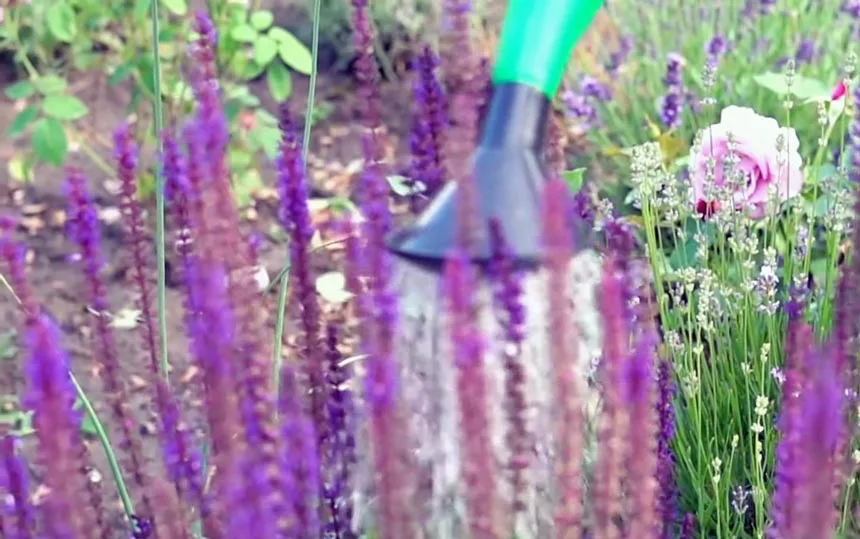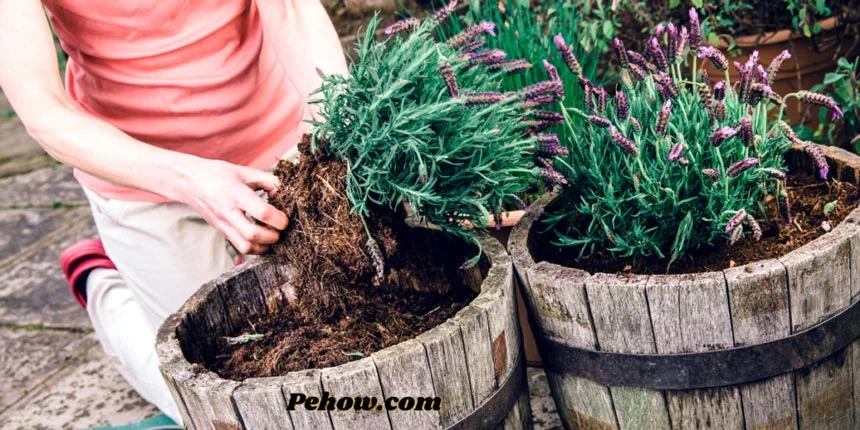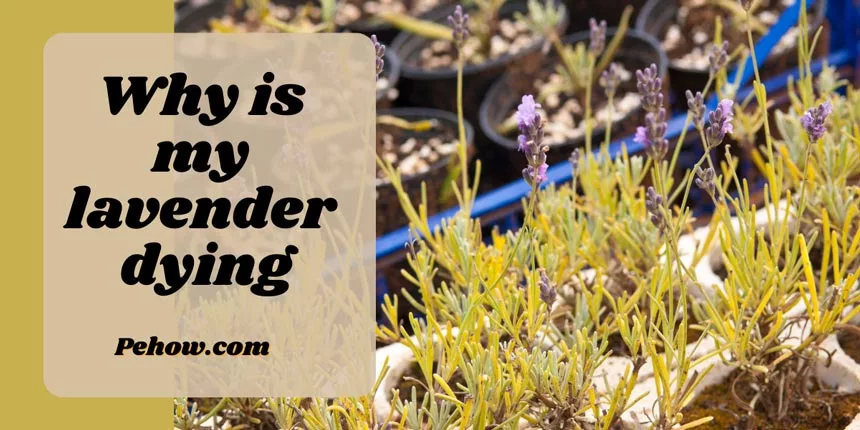Oh no! We’re so sorry to hear that your lavender is dying. I know how sad it is when lavender dies because it’s such a beautiful and fragrant plant.
Lavender is a beautiful, fragrant plant that can add a lot of charm to any garden. However, sometimes lavender plants can start to die for no apparent reason.
On the other hand, lavender can die for many reasons, such as water problems, too much heat, too much cold, pests, diseases, poor drainage, soil problems, or even improper pruning. Apart from these factors, old age can also lead to the death of lavender plants.
Lavender plants can be brought back from death with proper care and treatment. If you think your lavender plant is dying, then take a closer look at the plant and identify the problem. Once you know what’s wrong with the plant, you can take steps to fix the problem and save your lavender.
It is very painful to see a beloved plant withering away, but fortunately, some things can be done to save it. In this article, we will discuss some of the most common reasons why lavenders die and how to treat them.
Watering Problems
Many things can be responsible for the death of a lavender plant. I will give some possible reasons why your lavender plant may be dying.
1. Overwatering
Lavender plants need only be watered when the top inch of soil feels dry to the touch. If you water lavender plants too often, the roots can become saturated and rot. This will cause the plant to wilt and die. Signs of overwatering include brown leaves, wilting, and a sour smell from the plant.
2. Underwatering
Underwatering can also be responsible for the death of a lavender plant. If the soil is not kept moist, the plant will begin to wilt and die. Signs of underwatering include dry soil, wilting, and brown and crisp leaves. To prevent your lavender from dying from under watering, water the plant when the top inch of soil feels dry to the touch, and make sure to water evenly.
3. Improper Watering
The improper watering of plants is one of the most common reasons why they die. When you water your plants, do so properly and give them the right amount of water.
You don’t want to underwater or overwater your plants, which can both be detrimental to their health. Check the soil regularly to see if it’s wet, and adjust your watering schedule accordingly.
How To Fix Watering Problems

If you notice that your lavender is dying, then there may be a problem with how you water it. Here are some tips to help you fix any watering problems:
- Make sure you water your lavender frequently and give it plenty of water.
- Make sure that the soil is moist but not wet.
- If you live in a dry climate, consider using a water-retaining agent to help keep the soil moist.
- Avoid over-watering your lavender, as this can lead to root rot.
- If you still have problems, consider bringing your lavender plant indoors during the winter to help it survive.
Disease Problems
One of the main reasons lavender plants die is disease. The most common disease problems with lavender are fungal diseases such as root rot, powdery mildew, and leaf spot. These diseases can be caused by overwatering, poor drainage, or humid conditions.
If your lavender plant is suffering from a disease, you may see leaves that are yellowing, wilting, or covered in spots. The best way to prevent disease is to plant your lavender in well-drained soil and to water it only when the soil is dry. If you do notice a disease, you can try treating it with a fungicide.
1. Root rot
If you notice that your lavender plant is dying, and you believe it may be due to root rot, it is important to do some research to find out more about this disease. Root rot is a fungal infection that can affect the roots of lavender plants, and if left untreated, it can cause the plant to die (source).
Root rot symptoms include yellowing or wilting leaves and leaves covered in spots. If you think your lavender plant may have root rot, you can try treating it with a fungicide. However, the best way to prevent this disease is to ensure your plant has good drainage and is not overwatered.
2. Powdery mildew
Powdery mildew is another fungal disease that can affect lavender plants. This disease is caused by a fungus that grows on the surface of the plant, and it can cause the leaves to turn yellow and the plant to become stunted. If left untreated, powdery mildew can kill a lavender plant.
To prevent powdery mildew, make sure your plant has good air circulation and is not overwatered. You can also try treating the plant with a fungicide.
3. Leaf spot
Leaf spot is a fungal disease that can cause spots on the leaves of lavender plants. If left untreated, this disease can kill the plant. To prevent leaf spots, ensure your lavender plant has good air circulation and is not overwatered. You can also try treating the plant with a fungicide.
4. Verticillium wilt
Verticillium wilt is a fungal disease that can affect the leaves and stems of lavender plants. This disease is caused by a fungus that lives in the soil, and it can cause the plant to wilt and the leaves to turn yellow. If left untreated, verticillium wilt can kill a lavender plant.
5. Bacterial blight
Bacterial blight is a bacterial disease that can affect the leaves and stems of lavender plants. This disease is caused by bacteria in the soil, which can cause the plant to wilt and the leaves to turn yellow. If left untreated, bacterial blight can kill a lavender plant.
6. Chemical Burn
If you have treated your lavender plant with a chemical herbicide or pesticide and notice that the plant is dying, it is likely due to a chemical burn. The best way to prevent this problem is to follow the directions on the label of the product you are using. If you think a chemical has damaged your lavender plant, you can try treating it with an organic fertilizer.
lavender Plant Soil Problems

Soil problems are a common reason why lavender plants die. If the soil is too acidic, alkaline, or has too much salt, it can harm the plant. Over-watering or under-watering can also damage the plant. To ensure your lavender thrives, test your soil’s pH level and adjust it as needed, water the plant regularly, and avoid over-fertilizing.
1. What type of soil to use?
When planting lavender, it’s important to use the right soil type. Lavender thrives in sandy or loamy soil that is neutral or slightly alkaline. If your soil is acidic, you can add lime to make it more alkaline. If your soil is too sandy or has a lot of clay, you can add organic matter, such as compost, to help it retain water and nutrients.
2. Wrong Soil Acidity
One of the most common reasons why lavender plants die is because the soil is too acidic or alkaline. The ideal pH level for lavender is between 6.5 and 7.5. You can use a pH meter or test kit from a garden center to test your soil’s pH level. If the pH level is too high, you can add sulfur to lower it. If the pH level is too low, you can add lime to raise it.
3. Excess of Nitrogen in the Soil
Nitrogen is one of the most important nutrients for plants, but too much of it can be harmful. Plants can start to die when there is too much nitrogen in the soil.
This is because nitrogen encourages the growth of foliage, at the expense of flowers and fruits. In addition, too much nitrogen can also make plants more susceptible to pests and diseases.
If you are seeing signs that your lavender plant is dying due to an excess of nitrogen in the soil, you can take steps to correct the problem. First, you can add organic matter to the soil to help break down the nitrogen. You can also add a fertilizer that is low in nitrogen.
Finally, you can water your plants deeply and infrequently to help them absorb less nitrogen from the soil. With time and care, your lavender plant should start to recover.
Pest Problems
Pests can be a major problem for lavender plants, causing them to die. Several different pests can affect lavender, including Whiteflies, aphids, mites, and thrips. These pests can damage the plants by sucking sap from the leaves, eating the flowers and buds, and spreading disease.
1. Whiteflies
Whiteflies are a common pest that can affect lavender plants. These tiny, white insects can be difficult to see, but they can cause serious damage to plants by sucking sap from the leaves. Whitefly populations can quickly grow and spread, and they can also carry diseases that can infect plants.
There are several ways to control whiteflies, including using insecticides, removing infested plants, and using sticky traps or other methods to trap the insects. Treating an infestation as soon as it is noticed is important before the pests can do too much damage.
2. Aphids
Aphids are another type of pest that can affect lavender plants. These small, soft-bodied insects feed on the sap of plants and can cause damage by eating the leaves, flowers, and buds. Aphids can also spread diseases from plant to plant.
Aphids can be controlled with insecticides, but removing infested plants and destroying them is also important. Ladybugs and other predators can also help to control aphid populations.
3. Mites
Mites are tiny pests that feed on the leaves of plants. They can cause damage by eating leaves and flowers, and they can also spread diseases. Mites are difficult to control with insecticides.
4. Thrips
Thrips are small, winged insects that feed on the sap of plants. They can cause damage by eating leaves and flowers, and they can also spread diseases. Thrips can be controlled with insecticides, but removing infested plants and destroying them is also important.
5. Spittlebugs
Spittlebugs are a type of pest that can affect lavender plants. These small, soft-bodied insects feed on the sap of plants and can cause damage by eating the leaves, flowers, and buds. Spittlebugs can also spread diseases from plant to plant.
Spittlebugs can be controlled with insecticides, but removing infested plants and destroying them is also important. Ladybugs and other predators can also help to control spittlebug populations.
Temperature Problems
If you are experiencing temperature problems with your lavender plants, you can do a few things to help them. One common problem is that plants may not be getting enough sunlight. Make sure your lavender is in a sunny spot; if it isn’t, consider moving it.
Another issue that can cause problems for lavender is temperature fluctuations. The ideal temperature range for lavender is between 50 and 80 degrees Fahrenheit. If the temperature in your home is too hot or too cold, it may cause your plants to die.
To help keep the temperature consistent, try using a thermostat to regulate the temperature in your home. Finally, make sure you are watering your lavender regularly. If the plants are too dry, they will not be able to survive. Keep an eye on the soil and water when it is needed.
1. Night temperature
If your lavender is dying, it’s likely because the night temperature is too cold. Lavender plants need to be kept in a warm environment during the night to thrive. Ensure you keep your lavender where the temperature will not drop below 65 degrees Fahrenheit at night. If the temperature drops below this, your lavender will likely die.
2. Winter temperature
One possible reason why your lavender may be dying is because of the winter temperature. Lavender plants prefer cooler temperatures and may not do well in very cold weather. If the temperature drops below freezing, the plants can die. If you live in an area with cold winters, it’s important to protect your lavender plants from the weather by covering them with a tarp or burlap sack.
Fertilizer Problems
Fertilizers can save plants as well as kill them. If you use too much fertilizer or the wrong kind, it can “burn” plants. This is especially true of fast-release fertilizers. Fertilizer burn appears as a brown or yellow leaf and stunted growth.
The plant may drop leaves and stop growing altogether. If you think your plant has been burned by fertilizer, flush the soil with water to remove any remaining fertilizer. Then, cut back on fertilizers and be more careful in the future.
Here are a few things to keep in mind when fertilizing your lavender:
1. Use the right fertilizer
Make sure you’re using the right type of fertilizer for your plants. Many different types of fertilizer are available on the market, each designed for a specific type of plant. Be sure to use a fertilizer that’s specifically meant for lavender plants.
2. Don’t over-fertilize
It’s important to remember that lavender plants don’t need a lot of fertilizer – just a light application once or twice a year is usually enough. Over-fertilizing can damage your plants and stunt their growth.
3. Be careful with fast-release fertilizers
If you use a fertilizer, be sure to avoid any labeled as “fast-release.” These fertilizers can quickly release their nutrients into the soil, which can “burn” your plants. Slow-release fertilizers are a better option for lavender plants.
Pruning Problems
When removing dead or diseased branches from a lavender plant, pruning problems can occur. Improper pruning can damage the plant and lead to disease or even death. It is important to understand how and why to prune a lavender plant to avoid these problems.
1. Why Prune Lavender Plants?
Pruning is an important part of maintaining a lavender plant. Dead or diseased branches should be removed to prevent the spread of infection and to keep the plant healthy. Pruning also helps maintain the shape of the plant and encourages new growth. Proper pruning techniques should be used to avoid damage to the plant.
2. When to Prune Lavender Plants
The best time to prune lavender plants is early spring before new growth begins. This will give the plant time to heal and encourage new growth. Dead or diseased branches can be removed at any time.
3. How to Prune Lavender Plants
Lavender plants are a beautiful addition to any garden; with the right care, they can last for years. To keep your lavender plants looking their best, it’s important to know how to prune them properly. Here are a few tips:
- Prune your lavender plants in late winter or early spring before new growth begins.
- Cut back the old growth to about six inches from the ground.
- Leave plenty of new growth on the plant to continue growing and flaring.
- If your lavender plants are growing too tall, you can trim them back by about one-third.
- Make sure to remove any dead or damaged branches from the plant.
The Summary
Lavender plants are a beautiful and fragrant addition to any garden. However, they can be finicky plants and require special care. If you’re having problems with your lavender plants, it might be due to one of the issues discussed in this article.
Check the soil, water, and fertilizer before taking any other action. If all else fails, you can always consult with a professional.
I hope this has helped you learn about why my lavender is dying and how to fix the problem. If you have any other questions, please feel free to leave a comment below. Thanks for reading!



